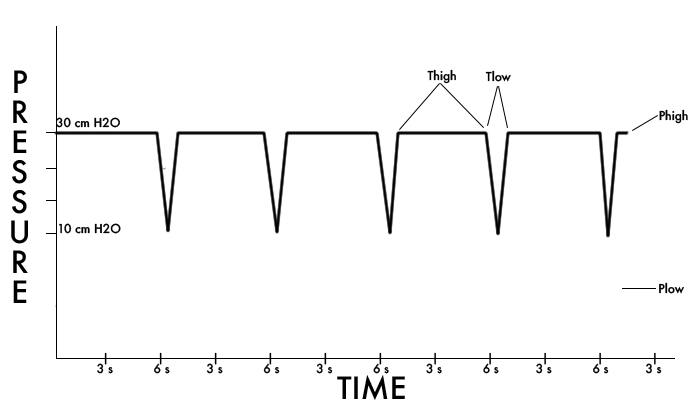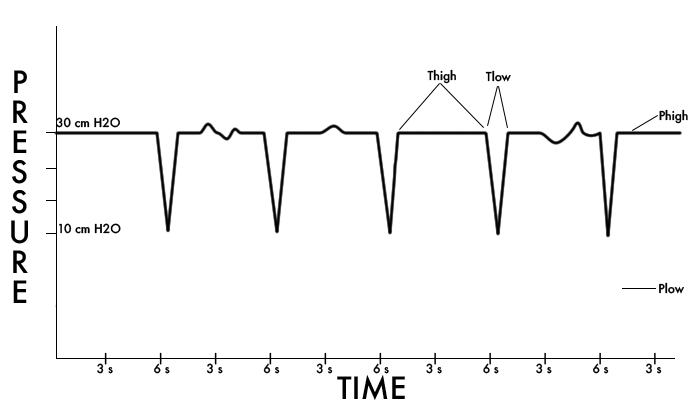Here we discuss HFOV and APRV.
Read the other entries from this series here: (1), (2), (3), (4), (5)
At least two types of ventilation exist in the wild that break most of the rules we’ve discussed. However, one you will rarely see anymore, so we’ll mention it briefly and get it off the table.
High Frequency Oscillatory Ventilation (HFOV)
Part of a family of related modalities (e.g. high frequency percussive ventilation, high frequency jet ventilation, etc), this concept turns the entire concept of ventilation on its head.
Rather than inducing a bulk flow of gas in and out of the lungs, “the oscillator” merely holds a fixed pressure in place, similar to a CPAP mode. Then, a vibrating speaker-like device shakes that air.
This induces numerous tiny eddies of air in the column of gas from the machine to the alveoli, which through complex microcurrents creates enough convective flow to ventilate CO2. Meanwhile, since the patient never “exhales” the bulk of air in the lungs, mean airway pressure is maintained, lung recruitment is excellent, and oxygenation is preserved.
Besides its role in neonatal care, which is a topic for a different website, HFOV was generally used as a rescue modality for severe ARDS. This all changed in 2013, when not one but two large RCTs were published (OSCAR and OSCILLATE), both showing increased mortality when oscillatory ventilation was compared against conventional modalities. This was unfortunately the death knell for what everyone considered a rather fun demonstration of respiratory physiology
An oscillator probably still exists somewhere in most hospitals, gathering dust in a basement, but I cannot think of an indication to apply it.
Not so for our other modality…
Airway Pressure Release Ventilation (APRV)
Sometimes referred to by tradenames “BiVent” or “BiLevel” (not to be confused with the non-invasive mode typically known as “BiPap”), this mode is similar to HFOV in one way: it arises from the philosophy of respiratory physiology known as “open lung ventilation.” This school of thought essentially dictates that certain patients, particularly those with difficulty oxygenating, derive the most benefit from recruiting as much of the lung as possible and then keeping it open.
In ordinary circumstances, we do this by PEEP, sometimes at high levels. Once we have PEEP at near-maximal levels, however, what next?
Other than FiO2, oxygenation is determined by a variable called Mean Airway Pressure, essentially the total pressure within the lungs over time (the area under the pressure curve). PEEP increases this, as does larger tidal volume breaths, but we try to avoid the latter as they may be injurious.
We can, however, increase mean airway pressure by prolonging the breath. If you take a Pressure Control mode and increase the inspiratory time long enough, eventually it will become very long indeed, basically a breath-hold. Ordinarily, expiration takes longer than inspiration, but nothing prevents us from extending inspiratory time until this is reversed (inverse ratio ventilation). If we made the I-time really long, we would eventually end up with something that looked like this:

This is APRV, essentially alternating levels of CPAP. Rather than typical respiratory rates, it has four variables:
- High pressure (Phigh)
- Low pressure (Plow)
- High time (Thigh)
- Low time (Tlow)
The Phigh is held for the duration of the Thigh, then dropped to the Plow for the duration of the Tlow, which is usually very short.
With typical values like a Phigh of 30 cm H2O and a Thigh of 3 seconds, it should be clear that APRV improves oxygenation. However, no air is moving during that long breath-hold, so ventilation can be poor. Hence the Plow, allowing intermittent “releases” of air to blow off CO2, followed immediately by a return to the Phigh.
The confusing aspect of APRV is that while these alternating levels of pressure look like “breaths,” and can function as breaths, the patient can actually breathe on top of them as well. In fact, he is encouraged to, and proponents of this mode like to call it “a spontaneous mode” and “pretty much CPAP.” At any point in the cycle, usually during the Thigh because it lasts much longer, spontaneous breathing can occur. So really, it looks like this:

Points to note about APRV:
- It is most commonly used as a rescue mode when a patient cannot adequately oxygenate despite maxed-out conventional therapies (100% FiO2, 20–25 PEEP, etc), which is usually due to ARDS. Some providers, however, use it more liberally, arguing for its value when applied routinely. Since this is less common, however, it can cause consternation in other members of the team who aren’t sure how to manage, wean, and troubleshoot this mode.
- APRV does reliably improve oxygenation, but like most last-ditch therapies for ARDS, has not demonstrated any benefit on mortality in large-scale trials. As a result, some providers simply don’t use it. Others are believers.
- Whether or not APRV is lung protective or lung injurious is a topic that starts food fights in the cafeteria.
- Plow is traditionally set to zero. However, Tlow is set so short that the Plow is never actually reached, as there is insufficient time to fully exhale. The actual Plow (essentially the PEEP) can therefore only be determined by inspecting the pressure and flow tracings.
- The “last ditch” crowd (those who use it at all) will typically revert to a conventional mode once the patient stabilizes. The “use it routinely” crowd will wean and even extubate still on APRV. This distinctive weaning process is called “drop and stretch” and is a topic for another day.
- Like any mode involving high levels of PEEP and high airway pressures, some concern should be maintained for the negative complications of high MAP, including the hemodynamic effects of decreased preload, the possibility for pneumothorax, and the great importance of avoiding derecruitment by disconnecting or opening the vent circuit.
Last words
That brings us to the end of our brief introduction to vent principles and modes. In the future, we’ll discuss PEEP and FiO2 in more depth, learn to make adjustments based upon blood gasses, develop a toolbox for troubleshooting problems, and touch upon other aspects of vent management.

Thousands of thanks!
I am a PGY2 who have no experience of ICU training yet. My family member experienced OHCA a few days ago, who is still in ICU by the support of the ventilator and vasopressors. This serie of the ventilator helped me a lot to explain to my other family members for the current condition. Again thanks!
My pleasure! Hope for the best for you.